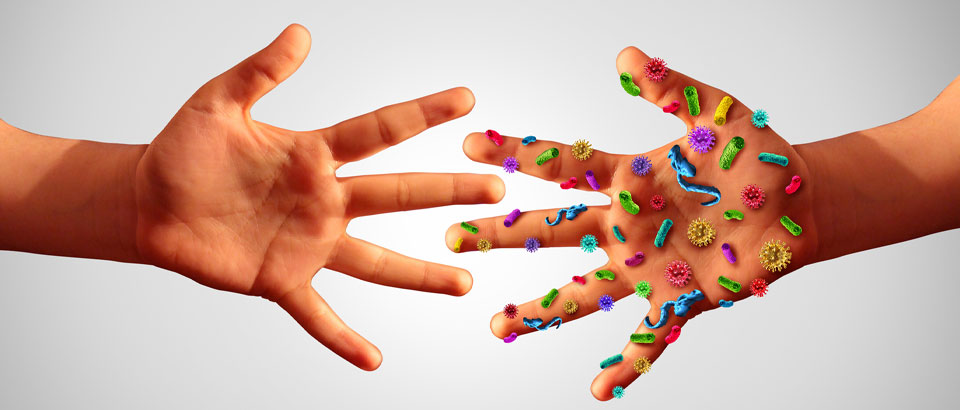December 12, 2022
For good reason, germs have a bad reputation. Strep throat, meningitis, food poisoning and a number of other infections are all caused by bacteria. We combat these germs by washing our hands, cleaning our counters and sinks, as well as any other areas where germs are known to live. However, not all bacteria are harmful. Some germs are beneficial to our bodies because they maintain a healthy gut. In our intestines, “good” bacteria help us utilize the nutrients in food and eliminate leftovers by producing waste.
When bacteria enter our bodies, they can cuddle up for an extended stay. They consume food and energy and some have the ability to produce toxins, which are proteins with poisonous effects. The symptoms of typical illnesses, such as fevers, runny nose, rashes, coughing, vomiting and diarrhea might be brought on by those toxins. Let’s dive in a little a little more and get the facts about bacteria and germs.

What are Germs?
Germs live everywhere. They are microorganisms that can be found all over the earth whether that be in the air, our food and even inside our bodies. There are many different types of harmful germs, here are a few common ones:
- Microorganisms with one cell make up bacteria. While certain bacteria are dangerous and can cause illness, others are helpful and can aid in the eradication of disease-causing pathogens. These tiny, single-celled organisms obtain the nutrition they need from their surroundings to survive, which is often the human body. As they spread illnesses, bacteria have the ability to proliferate both within and outside the body. Ear infections, tonsillitis, strep throat, cavities and pneumonitis are a few ailments that bacteria can cause.
- Even smaller than a single cell, viruses exist. When they reproduce, they harm the cells and make you ill. For these germs to develop and procreate, live cells are necessary. Most viruses cannot survive for very long outside of a living organism, such as a plant, animal or human. A virus’s host is whatever it inhabits. Viruses can spread and afflict humans when they enter their bodies. The flu, measles, chickenpox and many other illnesses are all brought on by viruses.
- Some fungi, including mushrooms and the yeast used in bread, are considered germs as well. These organisms resemble plants and are multicellular (consisting of many cells). Fungi cannot produce their own sustenance from soil, water and air like other plants can. Instead, fungus eats things like plants, people and animals for food. Many fungi are not harmful to healthy people, and they like to live in warm, humid environments. The itchy rash that people occasionally get between their toes, known as athlete’s foot, is an example of something brought on by fungi.
- Another type of germ is a protozoan, a single-celled organism that feeds on other. These single-celled organisms enjoy wetness, and they frequently transmit diseases via water. Diarrhea, nausea and abdominal discomfort are symptoms of several protozoa that cause intestinal infections.
- Roundworms and tapeworms are examples of helminths, which are bigger parasites and fall within the germ category.
Though germs aren’t known for aiding health, not all bacteria are bad. There are 100 trillion “good” bacteria that can live in our bodies, most of which live in our gastrointestinal tract, which is the pathway of the digestive system. These helpful bacteria are a necessity because they defend our bodies when the bad germs are ingested. Although, we sometimes endanger the community of helpful microorganisms. What do we mean by that? Well, when we use antibiotics to treat a bacterial infection, both harmful and beneficial bacteria are killed. This may result in an imbalance of bacteria in the body, which may cause diarrhea and other digestive issues.
Good bacteria create various vitamins in the intestinal tract, including folic acid, niacin, vitamins B6 and B12 and aid in the digestion of food and the absorption of nutrients. By crowding out their harmful relatives in the gut, producing acids that stop their growth, and triggering the immune system to fight them off, the good bacteria may also shield us from their disease-causing relatives, according to research.3
Balancing the Good with the Bad
The gut contains both good and bad germs. Good germs in the body are bacteria that are known to have a positive impact on health. At low levels, bad bacteria can exist in human bodies without causing significant harm. However, an imbalance of good and bad bacteria may contribute to negative outcomes. Many factors can contribute to this imbalance, including age, diet, medications and the presence of an infection or illness.
You can keep a healthy gut by giving these good germs a boost with prebiotics. Prebiotic foods can support the growth and health of probiotics, a category of good germs that are naturally present on your body. Prebiotics are probably already present in your diet without your knowledge. Furthermore, using personal care items containing these nutrients, such as prebiotic soap, can support the maintenance of a healthy balance on your skin.
Probiotics come in a variety of forms, such as lotions, suppositories and supplement capsules. Several foods contain beneficial microorganisms, like buttermilk cheeses and yogurt. Among the additional foods that contain friendly bacteria are fermented meals like kimchi, miso, tempeh, sauerkraut and sourdough bread.
Probiotics have also been suggested to prevent and treat a number of health issues including diarrhea, inflammatory bowel disease, Crohn’s illness and ulcerative colitis, decaying teeth, eczema, gingivitis and periodontitis. Probiotic supplements may enhance health, according to a few studies, but many scientists, including those at the Cleveland Clinic, claim that the evidence is insufficient to make a firm conclusion.5
Learn more about probiotics and maintaining your gut health in our blog!

Protecting Yourself From Bad Germs
The majority of bacteria are airborne when someone sneezes, coughs or even breathes. Blood, saliva and sweat can all carry germs. Some illnesses spread from person to person by contact with contaminated objects, such as shaking hands with someone who is sick before touching your own nose.
The best defense against germs is frequent and thorough hand washing and cleanliness of your living environments. But, keep in mind that some bacterial growth on the skin is quite normal. Although it’s imperative to wash your hands before eating or preparing food, after using the restroom or after coming into touch with a sick person. When you cough or sneeze, before you eat or prepare food, after using the restroom, after touching animals and pets, after playing outside, wash your hands immediately.
To prevent the spread of germs, cover your lips when you cough and your nose and mouth when you sneeze. When possible, use a tissue, then discard it. Cough or sneeze into your elbow rather than your hands if you don’t have a tissue handy. Although nobody enjoys getting shots, there are many vaccines, like your annual flu shot, that help keep your immune system healthy and ready to fight off infections. By eating healthily, exercising frequently and getting enough sleep, you can maintain a robust and healthy immune system. All of this will aid in your readiness to combat disease-causing microorganisms, also known as germs.
For us to stay healthy and need fewer medications, our immune system requires the correct mix of germs. However, sometimes the bad germs still get the best of us. That is why our centers are open from 8-8 and are here if you or your loved ones gets sick so we can get you back to being happy and healthy.
References:
1 Good vs. Bad Germs. Last updated February 8, 2017. Accessed September 19, 2022.
2 Bacteria: the Good, the Bad, and the Ugly. Accessed September 19, 2022.
3 Probiotics to enhance anti-infective defences in the gastrointestinal tract. Accessed September 19, 2022.
4 What is Good Bacteria? Last updated July 14, 2021. Accessed September 19, 2022.
5 Probiotics. Accessed September 19, 2022.
